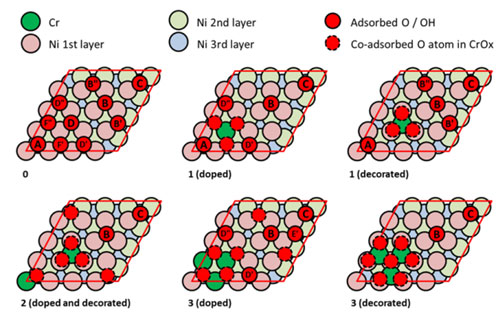Crossref Citations
This article has been cited by the following publications. This list is generated based on data provided by
Crossref.
Imadadulla, Mohammed
Nemakal, Manjunath
and
Koodlur Sannegowda, Lokesh
2018.
Solvent dependent dispersion behaviour of macrocycle stabilized cobalt nanoparticles and their applications.
New Journal of Chemistry,
Vol. 42,
Issue. 14,
p.
11364.
Xie, Lin
and
Kirk, Donald W.
2020.
Nickel catalyst migration in an anion exchange membrane fuel cell.
Electrochimica Acta,
Vol. 364,
Issue. ,
p.
137091.
Vandichel, Matthias
Laasonen, Kari
and
Kondov, Ivan
2020.
Oxygen Evolution and Reduction on Fe-doped NiOOH: Influence of Solvent, Dopant Position and Reaction Mechanism.
Topics in Catalysis,
Vol. 63,
Issue. 9-10,
p.
833.
Xu, Yijie
Sumboja, Afriyanti
Groves, Alexandra
Ashton, Thomas
Zong, Yun
and
Darr, Jawwad A.
2020.
Enhancing bifunctional catalytic activity of cobalt–nickel sulfide spinel nanocatalysts through transition metal doping and its application in secondary zinc–air batteries.
RSC Advances,
Vol. 10,
Issue. 68,
p.
41871.
Akbari, Nader
Kondov, Ivan
Vandichel, Matthias
Aleshkevych, Pavlo
and
Najafpour, Mohammad Mahdi
2021.
Oxygen-Evolution Reaction by a Palladium Foil in the Presence of Iron.
Inorganic Chemistry,
Vol. 60,
Issue. 8,
p.
5682.
Babu, Sreejith P.
and
Falch, Anzel
2022.
Recent Developments on Cr‐Based Electrocatalysts for the Oxygen Evolution Reaction in Alkaline Media.
ChemCatChem,
Vol. 14,
Issue. 15,
Salmanion, Mahya
Kondov, Ivan
Vandichel, Matthias
Aleshkevych, Pavlo
and
Najafpour, Mohammad Mahdi
2022.
Surprisingly Low Reactivity of Layered Manganese Oxide toward Water Oxidation in Fe/Ni-Free Electrolyte under Alkaline Conditions.
Inorganic Chemistry,
Vol. 61,
Issue. 4,
p.
2292.
Schaarschmidt, Joerg
Yuan, Jie
Strunk, Timo
Kondov, Ivan
Huber, Sebastiaan P.
Pizzi, Giovanni
Kahle, Leonid
Bölle, Felix T.
Castelli, Ivano E.
Vegge, Tejs
Hanke, Felix
Hickel, Tilmann
Neugebauer, Jörg
Rêgo, Celso R. C.
and
Wenzel, Wolfgang
2022.
Workflow Engineering in Materials Design within the BATTERY 2030+ Project.
Advanced Energy Materials,
Vol. 12,
Issue. 17,
Hossen, Md. Mosaddek
Hasan, Md. Shamim
Sardar, Md. Riajul Islam
Haider, Jahid bin
Mottakin
Tammeveski, Kaido
and
Atanassov, Plamen
2023.
State-of-the-art and developmental trends in platinum group metal-free cathode catalyst for anion exchange membrane fuel cell (AEMFC).
Applied Catalysis B: Environmental,
Vol. 325,
Issue. ,
p.
121733.





